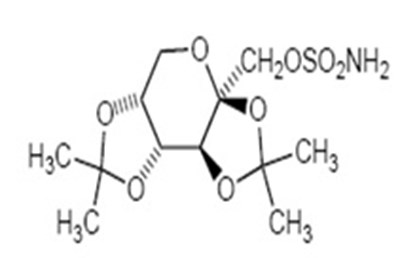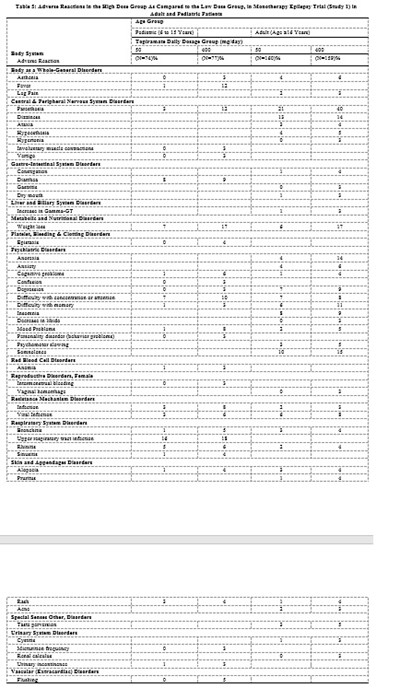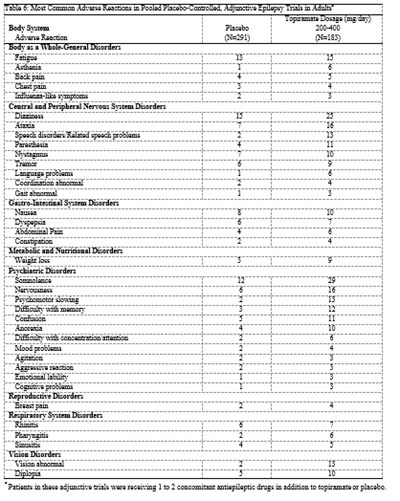Product Images Topiramate
View Photos of Packaging, Labels & Appearance
- 100mg - 100mg
- 200mg - 200mg
- 25mg - 25mg
- 50mg - 50mg
- Common-side effects - Common side effects
- Figure1 - Fig1
- Fig2 - Fig2
- Metabolic-acidosis symptoms - Metabolic acidosis symptoms
- Structure - Structure
- Symptom - Symptom
- Tab1 - Tab1
- Tab10 - Tab10
- Tab11 - Tab11
- Tab12 - Tab12
- Tab13 - Tab13
- Tab2 - Tab2
- Tab3 - Tab3
- Tab4 - Tab4
- Tab5 - Tab5
- Tab6 - Tab6
- Tab7 - Tab7
- Tab8 - Tab8
- Tab9 - Tab9
Product Label Images
The following 23 images provide visual information about the product associated with Topiramate NDC 43602-457 by Ascent Pharmaceuticals, Inc., such as packaging, labeling, and the appearance of the drug itself. This resource could be helpful for medical professionals, pharmacists, and patients seeking to verify medication information and ensure they have the correct product.
100mg - 100mg

This is a prescription drug called Topiramate. It comes in 100mg tablets and is dispensed by a pharmacist with a Medication Guide provided for each patient. Dosage and other required information can be found in the provided product literature. It should be stored in a tightly closed container between 20-25°C and protected from moisture. The drug is manufactured by Ascent Pharmaceuticals, Inc. located in Central Islip, NY 11722.*
200mg - 200mg
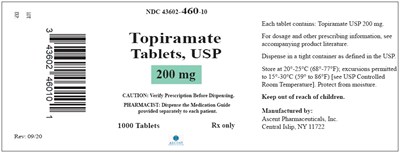
This is a description of Topiramate Tablets, which contain 200 mg of Topiramate USP. The package contains 1000 tablets and has an NDC number of 43602-460-10. The pharmacist must verify the prescription before dispensing the medication and provide the Medication Guide to each patient. The product should be stored in a tight container at temperatures of 20°C-25°C (68°F-77°F) with excursions permitted to 15°C-30°C (59°F-86°F) and protected from moisture. The tablets are manufactured by Ascent Pharmaceuticals, Inc in Central Islip, NY 11722.*
25mg - 25mg
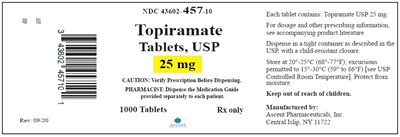
This is a description of a medication with the National Drug Code (NDC) number 43602-457-10 containing Topiramate USP in 25 mg tablets. The recommended storage temperature is between 20°-25°C (68°-77°F) with excursions permitted to 15°-30°C (59°-86°F). It is important for the pharmacist to verify the prescription before dispensing the medication and provide the medication guide to each patient. The tablets are manufactured by Ascent Pharmaceuticals, Inc. This medication must be kept out of reach of children.*
50mg - 50mg
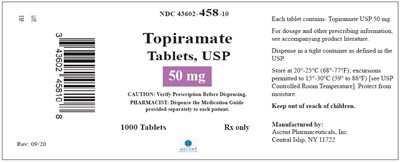
This is a pharmaceutical label for Topiramate Tablets, USP which contains 50mg of the active ingredient. The label includes cautionary instructions for pharmacists to verify prescription information and to dispense the medication guide to each patient. The tablets, which come in a container fitted tightly according to USP standards, are to be stored between 20°-25°C (68°-77°F) and protected from moisture. The product literature provides dosage and other prescribing information. The tablets are manufactured by Ascent Pharmaceuticals, Inc. in Central Islip, NY 11722.*
Common-side effects - Common side effects

The given text describes the various symptoms of an ailment, which may include tingling sensation in arms and legs, loss of appetite, nausea, changed taste of food, diarrhea, weight loss, nervousness, respiratory tract infections, speech problems, tiredness, dizziness, sleepiness, slow reactions, memory difficulties, abdominal pain, fever, abnormal vision, and decreased feeling or sensitivity.*
Figure1 - Fig1

This is a chart displaying the Kaplan-Meier estimates of cumulative rates for time to first seizure in Study 1. It is not available to infer additional information from the given text.*
Fig2 - Fig2
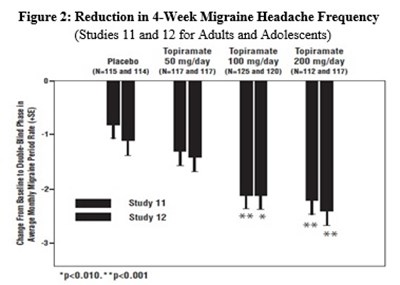
The text describes a figure labeled as "Figure 2" that shows the reduction in the frequency of migraine headaches over 4 weeks. It includes data from studies 11 and 12 for adults and adolescents. There are some characters that are not English and may have resulted from errors.*
Metabolic-acidosis symptoms - Metabolic acidosis symptoms
This appears to be a list of symptoms that may indicate a medical issue. The symptoms listed are feeling tired, changes in heartbeat, loss of appetite, and trouble thinking clearly. It is important to note that these symptoms could be a sign of many different medical conditions, so it is best to consult with a healthcare provider for a proper diagnosis and treatment plan.*
Symptom - Symptom

This text seems to be discussing various behavioral and mood-related symptoms that are associated with depression, anxiety, and potentially suicidal ideation. It describes symptoms such as thoughts about suicide or dying, attempts to commit suicide, new or worsening depression and anxiety, feelings of agitation or restlessness, panic attacks, insomnia, irritability, aggression, violent behavior, dangerous impulses, extreme increases in activity and talking (manic episodes), and other unusual changes in behavior or mood. These symptoms may require prompt attention and treatment by a mental health professional.*
Tab1 - Tab1

This is a titration schedule for monotherapy for both adults and pediatric patients who are 10 years and older. The table shows the morning and evening dosage for different weeks, ranging from 2mg to 200mg.*
Tab10 - Tab10
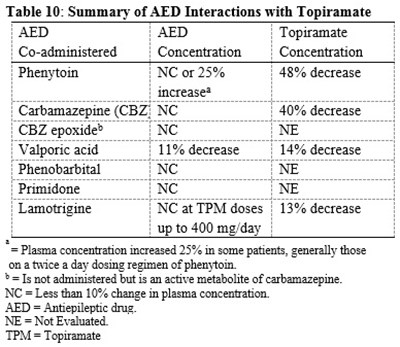
The table summarizes the interactions between AED (Antiepileptic drugs) and Topiramate. The concentration increases by 25% in some patients who take Topiramate five times a day. Carbamazepine's active metabolite does not affect TPM. NCor25% increase and 9% decrease in concentration are also seen. The table concludes with abbreviations such as AED, TPM, and NE, which are used throughout the text.*
Tab11 - Tab11
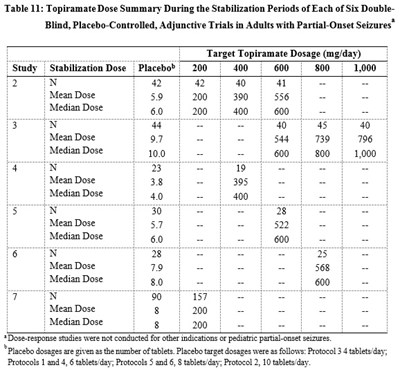
This is a table showing the summary of topiramate dosage during six double-blind, placebo-controlled trials for adults with partial-onset seizures. The target dosages ranged from 8 to 200mg/day. It is noted that dose response studies were not conducted for other indications or pediatric seizures, and placebo dosages are given in the number of tablets. The target placebo dosages also vary among the six protocols listed in the table.*
Tab13 - Tab13

The table shows the percent reduction from the baseline in the average monthly attack rate of Study 13, using the Intent-to-Treat Analysis Set. The categories include Placebo, Topiramate 50 mg/day, and Topiramate 100 mg/day. The baseline median value is 56, and the last 12 weeks of the double-blind phase median value ranges from 51 to 35. The percent reduction values for Topiramate 50 mg/day and 100 mg/day are -3 and -3, respectively. The Placebo category is also included. The table utilizes an ANCOVA model on ranks with factors that include baseline, treatment group, and analysis center. It also includes monthly migraine attack as a covariate. The adjusted p-value for the four dose groups is calculated using the Hochberg multiple comparison procedure.*
Tab2 - Tab2

The text describes a table titled 'Monotherapy Target Total Daily Maintenance Dosing for Patients 2 to 9 Years of Age'. The table has information on the total daily dose (in mg/day) to be administered to patients of different weights in the specified age range, for single-drug therapy. The minimum and maximum maintenance doses are listed for each weight category. The doses are to be administered in two equally divided doses.*
Tab3 - Tab3

This is a table that outlines the titration schedule for preventive treatment of migraines in patients who are 12 years of age or older. The table shows the dosage for the morning and evening for each week of treatment. In the first week, there is no dose in the morning, and the evening dose is 25mg. The dosage gradually increases over the next three weeks, with the morning dose increasing to 25mg in week two, to mg in week three, and to 50mg in week four. The evening dose increases similarly, starting at 25mg in week two and ending at 50mg in week four.*
Tab4 - Tab4

This is a table that shows the relative risk and risk difference for using antiepileptic drugs in different indications. The indications listed are epilepsy, psychiatric, and other. The table shows that there is a higher incidence of events (side effects or negative outcomes) in drug patients than in placebo patients, with the highest incidence seen in the psychiatric indication. The table also shows that using antiepileptic drugs for epilepsy has a lower risk than using it for the other indications listed.*
Tab9 - Tab9

Table 9 provides information on the adverse reactions in pediatric patients aged 12 to 17 years who were given Toprats for preventive migraine treatment. The table lists various dosage amounts and associated adverse effects. Adverse reactions are divided among different body systems, such as central and peripheral nervous systems, gastrointestinal systems, respiratory systems, special senses, and more. The report includes the incidence of adverse reactions in terms of subjects experiencing the events and the number of events, alongside the studies used.*
* The product label images have been analyzed using a combination of traditional computing and machine learning techniques. It should be noted that the descriptions provided may not be entirely accurate as they are experimental in nature. Use the information in this page at your own discretion and risk.
